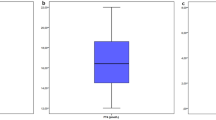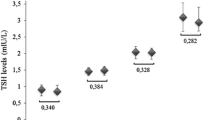Abstract
Morbid obesity is associated with a high rate of raised serum TSH associated with normal free thyroid hormones. The body repercussions of this thyroid abnormality, suggesting subclinical hypothyroidism, are still debated. In particular, it is unclear whether the raised serum TSH of obesity results in changes of circulating lipids typically observed in hypothyroidism. Aim of this study was to evaluate the impact of a raised serum TSH on the lipid profile in morbid-obese and non-obese patients. Serum TSH, FT4, FT3, Tg-Ab, TPO-Ab and lipids were measured in 55 morbid-obese (BMI > 40 kg/m2) and 55 non-obese (BMI < 30 kg/m2) patients with a raised serum TSH. Despite similar serum levels of TSH, FT4 and FT3, morbid-obese patients displayed significantly lower mean levels of total cholesterol (200.8 ± 35.6 vs. 226.9 ± 41.4 mg/dl, p < 0.001) and a significantly lower prevalence of hypercholesterolemia (50.9 vs. 72.7 %, p < 0.01) when compared with non-obese patients. Morbid-obese patients also had lower mean serum HDL cholesterol and higher serum triglycerides. The impact of a raised serum TSH on the lipid profile differs in morbid-obese compared to non-obese patients, suggesting that obese patients might not be truly hypothyroid. Measuring total cholesterol could be a helpful tool for deciding whether a morbid-obese patient with a raised serum TSH should be given levothyroxine treatment.


Similar content being viewed by others
References
D.H. Bessesen, Update on obesity. J. Clin. Endocrinol. Metab. 93, 2027–2034 (2008)
C.L. Ogden, M.D. Carroll, L.R. Curtin, M.A. McDowell, C.J. Tabak, K.M. Flegal, Prevalence of overweight and obesity in the United States, 1999–2004. JAMA 295, 1549–1555 (2006)
P. Kokkoris, F.X. Pi-Sunyer, Obesity and endocrine disease. Endocrinol. Metab. Clin. North Am. 32, 895–914 (2005)
L. Douyon, D. Schteingart, Effect of obesity and starvation on thyroid hormone, growth hormone, and cortisol secretion. Endocrinol. Metab. Clin. North Am. 31, 173–189 (2002)
R. Sari, M. Kemal Balci, H. Altunbas, U. Karayalcin, The effect of body weight and weight loss on thyroid volume and function in obese women. J. Clin. Endocrinol. 59, 258–262 (2003)
M.A. Michalaki, A.G. Vagenakis, A.S. Leonardou, M.N. Argentou, I.G. Habeos, M.G. Makri, A.I. Psyrogiannis, F.E. Kalfarentzos, V.E. Kyriazopoulou, Thyroid function in humans with morbid obesity. Thyroid 16, 73–78 (2006)
N. Manji, K. Boelaert, M.C. Sheppard, R.L. Holder, S.C. Gough, J.A. Franklyn, Lack of association between serum TSH or free T4 and body mass index in euthyroid subjects. J. Clin. Endocrinol. 64, 125–128 (2006)
G. De Pergola, A. Ciampolillo, S. Paolotti, P. Trerotoli, R. Giorgino, Free triiodothyronine and thyroid stimulating hormone are directly associated with waist circumference, independently of insulin resistance, metabolic parameters and blood pressure in overweight and obese women. J. Clin. Endocrinol. 67, 265–269 (2007)
M. Bastemir, F. Akin, E. Alkis, B. Kaptanoglu, Obesity is associated with increased serum TSH level, independently of thyroid function. Swiss Med. Wkly 137, 431–434 (2007)
N. Knudsen, P. Laurberg, L.B. Rasmussen, I. Bulow, H. Perrild, L. Ovesen, T. Jorgensen, Small differences in thyroid function may be important for body mass index and the occurrence of obesity in the population. J. Clin. Endocrinol. Metab. 90, 4019–4024 (2005)
B. Biondi, Thyroid and obesity: an intriguing relationship. J. Clin. Endocrinol. Metab. 95, 3614–3617 (2010)
P. Marzullo, A. Minocci, M.A. Tagliaferri, G. Guzzaloni, A. Di Blasio, C. De Medici, G. Aimaretti, A. Liuzzi, Investigations of thyroid hormones and antibodies in obesity: leptin levels are associated with thyroid autoimmunity independent of bioanthropometric, hormonal, and weight-related determinants. J. Clin. Endocrinol. Metab. 95, 3965–3972 (2010)
M. Rotondi, P. Leporati, A. La Manna, B. Pirali, T. Mondello, R. Fonte, F. Magri, L. Chiovato, Raised serum TSH levels in patients with morbid obesity: is it enough to diagnose subclinical hypothyroidism? Eur. J. Endocrinol. 160, 403–408 (2009)
M. Rotondi, F. Magri, L. Chiovato, Thyroid and obesity: not a one-way interaction. J. Clin. Endocrinol. Metab. 96, 344–346 (2011)
G. Radetti, W. Kleon, F. Buzi, C. Crivellaro, L. Pappalardo, N. di Iorgi, M. Maghnie, Thyroid function and structure are affected in childhood obesity. J. Clin. Endocrinol. Metab. 3, 4749–4754 (2008)
M. Rotondi, C. Cappelli, P. Leporati, S. Chytiris, F. Zerbini, R. Fonte, F. Magri, M. Castellano, L. Chiovato, A hypoechoic pattern of the thyroid at ultrasound does not indicate autoimmune thyroid diseases in patients with morbid obesity. Eur. J. Endocrinol. 163, 105–109 (2010)
D.S. Cooper, Clinical practice. Subclinical hypothyroidism. N. Engl. J. Med. 345, 260–265 (2010)
A.R. Cappola, P.W. Ladenson, Hypothyroidism and atherosclerosis. J. Clin. Endocrinol. Metab. 88, 2438–2444 (2003)
R.E. Weiss, R.L. Brown, Doctor…could it be my thyroid? Arch. Intern. Med. 168, 568–569 (2000)
A.R. Ayala, M.D. Danese, P.W. Ladenson, When to treat mild hypothyroidism. Endocrinol. Metab. Clin. North Am. 29, 399–415 (2000)
L.H. Duntas, Thyroid disease and lipids. Thyroid 12, 287–293 (2002)
M.D. Danese, P.W. Ladenson, C.L. Meinert, N.R. Powe, Clinical review 115: effect of thyroxine therapy on serum lipoproteins in patients with mild thyroid failure: a quantitative review of the literature. J. Clin. Endocrinol. Metab. 85, 2993–3001 (2000)
F. Alibaz Oner, S. Yurdakul, E. Oner, A. Kubat Uzum, M. Erguney, Evaluation of the effect of L-thyroxin therapy on endothelial functions in patients with subclinical hypothyroidism. Endocrine 40, 280–284 (2011)
O. Topaloglu, F. Gokay, K. Kucukler, F.S. Burnik, T. Mete, H.C. Yavuz, D. Berker, S. Guler, Is autoimmune thyroiditis a risk factor for early atherosclerosis in premenopausal women even if in euthyroid status? Endocrine. (2012). doi:10.1007/s12020-012-9842-5
B. Biondi, D.S. Cooper, The clinical significance of subclinical thyroid dysfunction. Endocr. Rev. 29, 76–131 (2008)
B.O. Asvold, L.J. Vatten, T.I. Nilsen, T. Bjøro, The association between TSH within the reference range and serum lipid concentrations in a population-based study. The HUNT Study. Eur. J. Endocrinol. 156, 181–186 (2007)
G. Iacobellis, M.C. Ribaudo, A. Zappaterreno, C.V. Iannucci, F. Leonetti, Relationship of thyroid function with body mass index, leptin, insulin sensitivity and adiponectin in euthyroid obese women. J. Clin. Endocrinol. 62, 487–491 (2005)
E.A. Palmieri, S. Fazio, G. Lombardi, B. Biondi, Subclinical hypothyroidism and cardiovascular risk: a reason to treat? Treat Endocrinol. 3, 233–244 (2004)
F.J. Tinahones, L. Garrido-Sanchez, M. Miranda, J.M. García-Almeida, M. Macias-Gonzalez, V. Ceperuelo, E. Gluckmann, J. Rivas-Marin, J. Vendrell, E. García-Fuentes, Obesity and insulin resistance-related changes in the expression of lipogenic and lipolytic genes in morbidly obese subjects. Obes. Surg. 20, 1559–1567 (2010)
T. Reinehr, G. De Sousa, W. Andler, Hyperthyrotropinemia in obese children is reversible after weight loss and is not related to lipids. J. Clin. Endocrinol. Metab. 91, 3088–3091 (2006)
M. Tagliaferro, M.E. Berselli, G. Calò, A. Minocci, G. Savia, M.L. Petroni, G.C. Viberti, A.G. Liuzzi, Subclinical hypothyroidism in obese patients: relation to resting energy expenditure, serum leptin, body composition, and lipid profile. Obes. Res. 9, 196–201 (2001)
Y. Raftopoulos, D.J. Gagné, P. Papasavas, F. Hayetian, J. Maurer, P. Bononi, P.F. Caushaj, Improvement of hypothyroidism after laparoscopic Roux-en-Y gastric bypass for morbid obesity. Obes. Surg. 14, 509–513 (2004)
G. Michalopoulou, M. Alevizaki, G. Piperingos, D. Mitsibounas, E. Mantzos, P. Adamopoulos, D.A. Koutras, High serum cholesterol levels in persons with ‘high-normal’ TSH levels: should one extend the definition of subclinical hypothyroidism? Eur. J. Endocrinol. 138, 141–145 (1998)
Acknowledgments
The study was supported in part by funds from Progetto Ricerca Finalizzata 2005 “Rete Obesità” Italian Ministry of Health.
Conflict of interest
The authors have no conflict of interest that could be perceived as prejudicing the impartiality of the research reported.
Author information
Authors and Affiliations
Corresponding author
Rights and permissions
About this article
Cite this article
Rotondi, M., Leporati, P., Rizza, M.I. et al. Raised serum TSH in morbid-obese and non-obese patients: effect on the circulating lipid profile. Endocrine 45, 92–97 (2014). https://doi.org/10.1007/s12020-013-9928-8
Received:
Accepted:
Published:
Issue Date:
DOI: https://doi.org/10.1007/s12020-013-9928-8




